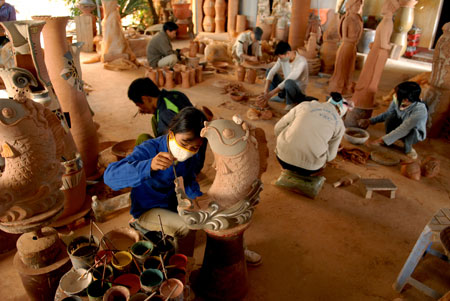Preserving and promoting cultural heritage of traditional craft villages

Pottery making in Phu Lang, Que Vo Town
Along with industrial development, Bac Ninh always focuses on preserving traditional cultural values, especially implementing many solutions to restore and create opportunities and conditions for traditional craft villages to develop by encouraging creativity, diversifying products, expanding craft village tourism services, gradually forming attractive tourist destinations, and serving domestic and international tourists.
According to historical sources, traditional crafts and craft villages were formed and developed in the ancient land of Kinh Bac-BBac Ninh before the Common Era and developed widely. During the French colonial period, Bac Ninh was considered the most important province of Bac Ky, rich in local products and technology, typically embroidery products exported to France and the United States. In Hanoi at that time, there was also Bac Ninh Street with 32 handicraft stalls. Through many historical ups and downs of existence and development, traditional crafts and craft villages are a precious cultural heritage of the homeland, an important and typical element of Kinh Bac culture, and a great resource for socio-economic development, attracting many domestic and foreign tourists to visit and learn about the history and culture of Bac Ninh and Kinh Bac.
Bac Ninh has many traditional craft villages such as Dong Ho folk painting craft (Thuan Thanh), Phu Lang pottery craft (Que Vo), Xuan Lai bamboo craft, Dai Bai bronze casting (Gia Binh), Da Hoi iron and steel forging craft in Chau Khe, Dong Ky, Phu Khe, Huong Mac fine art wood carving craft (Tu Son), Dong Cao, Dao Xa, Cham Khe paper making craft (Bac Ninh city)... In addition, there are many craft villages processing agricultural products and food, making famous specialties such as Tra Lam tofu craft, Bui Xa spring rolls, Phu The Dinh Bang cakes, Khac Niem vermicelli, etc.
Currently, the cultural heritage of traditional craft villages is being preserved and promoted by all levels, sectors, and localities. The system of communal houses, temples, and mausoleums worshipping the founder of the craft is classified by the state for protection and restored by the local people. Festivals in craft villages are maintained. Some traditional craft villages are included in the list of national intangible cultural heritage. Many honored artisans still work day and night diligently, tirelessly preserving and passing on the quintessence to the next generation.
The province has 62 traditional craft villages operating in most fields, accounting for about 10% of the total number of traditional craft villages nationwide. Through actual surveys, most families and production facilities in traditional craft villages are approaching the market by improving products, changing designs, and finding new directions. For example, Phu Lang pottery village has added ceramic paintings to decorate the walls; some facilities organize experiential activities to serve tourists. Xuan Lai Bamboo Village produces many interior products and decorations to suit consumer tastes. Dong Ho Painting Village also creates new painting models, flexibly applying them to materials and utensils and combining them with sightseeing activities. However, most of Bac Ninh's craft village products currently do not have trademarks, have not been registered for intellectual property protection, and have unstable consumption markets through many intermediaries.
The preservation and sustainable development of traditional craft village heritage in the context of international integration requires many synchronous and practical solutions, with policies and mechanisms to encourage and create favorable conditions for organizations and individuals to invest in the preservation and development of craft villages; actively innovate and apply science and technology in production, diversify products in terms of design and style, improve productivity and quality, and increase the competitiveness of products; strengthen cooperation, exchange, cultural integration, and product promotion; focus on planning key craft villages, orienting research, and exploiting tangible and intangible cultural values of craft villages in tourism activities.






